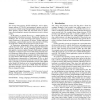Free Online Productivity Tools
i2Speak
i2Symbol
i2OCR
iTex2Img
iWeb2Print
iWeb2Shot
i2Type
iPdf2Split
iPdf2Merge
i2Bopomofo
i2Arabic
i2Style
i2Image
i2PDF
iLatex2Rtf
Sci2ools
ASPLOS
2011
ACM
2011
ACM
Mnemosyne: lightweight persistent memory
New storage-class memory (SCM) technologies, such as phasechange memory, STT-RAM, and memristors, promise user-level access to non-volatile storage through regular memory instructions. These memory devices enable fast user-mode access to persistence, allowing regular in-memory data structures to survive system crashes. In this paper, we present Mnemosyne, a simple interface for programming with persistent memory. Mnemosyne addresses two challenges: how to create and manage such memory, and how to ensure consistency in the presence of failures. Without additional mechanisms, a system failure may leave data structures in SCM in an invalid state, crashing the program the next time it starts. In Mnemosyne, programmers declare global persistent data with the keyword “pstatic” or allocate it dynamically. Mnemosyne provides primitives for directly modifying persistent variables and supports consistent updates through a lightweight transaction mechanism. Compared to past work on disk-base...
3 Microseconds | ASPLOS 2011 | Persistence Strategies | Persistent Variables | Programming Languages |
| Added | 24 Aug 2011 |
| Updated | 24 Aug 2011 |
| Type | Journal |
| Year | 2011 |
| Where | ASPLOS |
| Authors | Haris Volos, Andres Jaan Tack, Michael M. Swift |
Comments (0)

